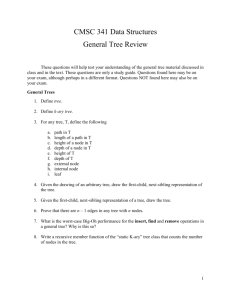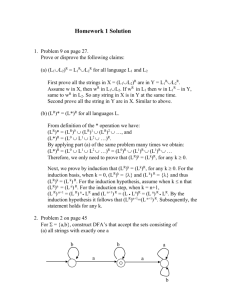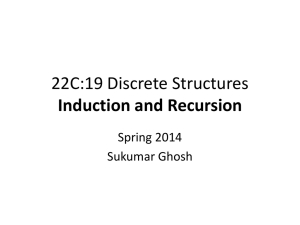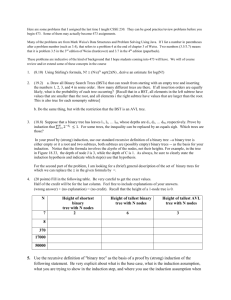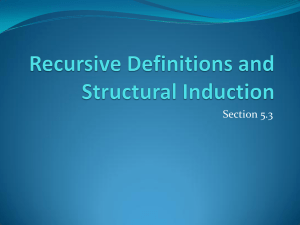CSE 311 Assignment #6: Induction, Trees, Regular Expressions
advertisement
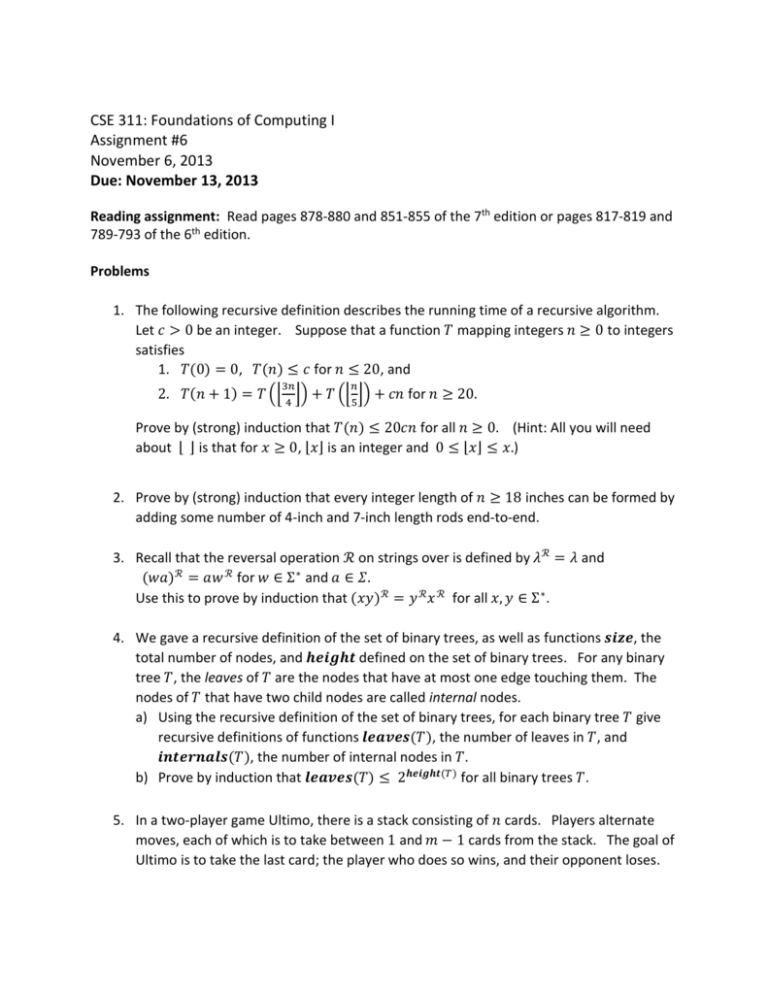
CSE 311: Foundations of Computing I Assignment #6 November 6, 2013 Due: November 13, 2013 Reading assignment: Read pages 878-880 and 851-855 of the 7th edition or pages 817-819 and 789-793 of the 6th edition. Problems 1. The following recursive definition describes the running time of a recursive algorithm. Let 𝑐 > 0 be an integer. Suppose that a function 𝑇 mapping integers 𝑛 ≥ 0 to integers satisfies 1. 𝑇(0) = 0, 𝑇(𝑛) ≤ 𝑐 for 𝑛 ≤ 20, and 3𝑛 𝑛 2. 𝑇(𝑛 + 1) = 𝑇 (⌊ 4 ⌋) + 𝑇 (⌊ 5⌋) + 𝑐𝑛 for 𝑛 ≥ 20. Prove by (strong) induction that 𝑇(𝑛) ≤ 20𝑐𝑛 for all 𝑛 ≥ 0. (Hint: All you will need about ⌊ ⌋ is that for 𝑥 ≥ 0, ⌊𝑥⌋ is an integer and 0 ≤ ⌊𝑥⌋ ≤ 𝑥.) 2. Prove by (strong) induction that every integer length of 𝑛 ≥ 18 inches can be formed by adding some number of 4-inch and 7-inch length rods end-to-end. 3. Recall that the reversal operation ℛ on strings over is defined by 𝜆ℛ = 𝜆 and (𝑤𝑎) ℛ = 𝑎𝑤 ℛ for 𝑤 ∈ Σ ∗ and 𝑎 ∈ 𝛴. Use this to prove by induction that (𝑥𝑦) ℛ = 𝑦 ℛ 𝑥 ℛ for all 𝑥, 𝑦 ∈ Σ ∗ . 4. We gave a recursive definition of the set of binary trees, as well as functions 𝒔𝒊𝒛𝒆, the total number of nodes, and 𝒉𝒆𝒊𝒈𝒉𝒕 defined on the set of binary trees. For any binary tree 𝑇, the leaves of 𝑇 are the nodes that have at most one edge touching them. The nodes of 𝑇 that have two child nodes are called internal nodes. a) Using the recursive definition of the set of binary trees, for each binary tree 𝑇 give recursive definitions of functions 𝒍𝒆𝒂𝒗𝒆𝒔(𝑇), the number of leaves in 𝑇, and 𝒊𝒏𝒕𝒆𝒓𝒏𝒂𝒍𝒔(𝑇), the number of internal nodes in 𝑇. b) Prove by induction that 𝒍𝒆𝒂𝒗𝒆𝒔(𝑇) ≤ 2𝒉𝒆𝒊𝒈𝒉𝒕(𝑇) for all binary trees 𝑇. 5. In a two-player game Ultimo, there is a stack consisting of 𝑛 cards. Players alternate moves, each of which is to take between 1 and 𝑚 − 1 cards from the stack. The goal of Ultimo is to take the last card; the player who does so wins, and their opponent loses. Prove by induction on 𝑛 that for 𝑛 > 𝑚, under the best possible play by both players, the first player to move will lose if 𝑛 ≡ 0 (mod 𝑚) but will win if 𝑛 ≢ 0 (mod 𝑚). 6. Construct regular expressions that match (generate) each of the following sets of strings a) The set of all binary strings that end with 0 and have even length, or start with 1 and have odd length. b) The set of all binary strings that have a 1 in every even-numbered position counting from the start of the string with the start of the string counting as position 1. 7. Construct regular expressions that match (generate) each of the following sets of strings. a) The set of all binary strings that contain at least two 1's and at most two 0's. b) The set of all binary strings that don't contain 001. Extra credit: Using the same definition of reversal as in problem 3, prove by structural induction that (𝑥 ℛ ) ℛ = 𝑥 for all strings 𝑥 ∈ Σ ∗ .

